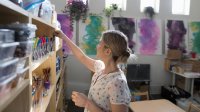Decluttering Your Classroom
Thoughtful reflection will help you make decisions about what to keep and what to discard in your classroom.
Your content has been saved!
Go to My Saved Content.Anybody who knows me would question whether I have the qualifications to talk about decluttering a classroom. For years I joked that my room was a picture of my brain merged with those of my middle schoolers. It was “organized chaos,” to quote Ray Bradbury. I was charmed by my own disorganization.
Lately, however, the obsession with decluttering our homes has gotten to me, and I believe those same principles can be used in my classroom.
Research tells us that the classroom environment is vital, and recent reports show that our rooms can have too much of a good thing. Posters, for example, might make a room feel inviting or engaging, but having too many can distract students. Flexible seating honors student choice and voice, but those pillows can also take up tons of room. And just as a closet at home can be full of clothes that are never worn, a cabinet can be full of student work collected over the years that no longer applies to current units or skills.
So this year I’m looking more critically at my clutter. As a result, I’m also reflecting on my pedagogy.
A Window Into My Current Classroom
I have my room divided into different purposes. There’s the area of equipment, punctuated by the wires and cords spilling from my Chromebook cart. I have a section for makerspace materials. My classroom used to be the main office, so I’ve repurposed the cubbies used in the mailroom as shelves for supplies.
I have flexible seating, which is wonderful, but it causes a shift in what one sees every day. Sometimes the beanbags are propped against the wall, and sometimes chairs are rolled into a group near the classroom library. Sometimes the video game chairs are huddled into a collaborative circle, and sometimes the easy chair has been dragged toward the makeshift window seat. There’s an ebb and flow of seating at all times.
My walls drive some of my students nuts. I’m more likely to hit an 88-degree angle when creating a corner with a bulletin board, and I admit that I sometimes outsource that job to a student just rarin’ to fix my attempt. I have no pride—I’m happy to hand it over.
When you open my cabinets, there’s little order. The items inside reflect quick sweeping-under-the-carpet kind of organization. There are student exemplars representing years of samples. There are old and retired textbooks, and cables from equipment now warehoused. There are board games and art supplies, recycled borders to be used another year, and boxes of worksheets that were over-copied or printed out before a computer program was made defunct.
But it’s important to also give a nod to what works. My current walls honor the fact that learning is messy. I display more about the process than the product of what my students have done. It’s an environment filled with posters of brainstorms, rough drafts as well as final artifacts, norms constructed collaboratively with my students, and project-based learning walls that morph with each unit and the growing lists of student-generated questions about the projects.
My room is a growing portfolio of student input, and as a result, we have a classroom environment that is as dynamic as the middle school brain. Because my students are the ones doing the stapling and the scribing, they have a hand in creating an environment that adds to the culture of the classroom.
So how does one declutter their classroom and still honor that culture?
Reflecting as a Tool for Decluttering
When making decisions in the classroom about what to keep and what to discard, a teacher needs to consider several questions.
Wall displays: Do these encourage thinking? Are they appealing? If visual displays aren’t an area of strength for you, might you consult with colleagues about content and with students about aesthetics?
Older student work: Is this still an important skill for current students to learn? Does the exemplar trigger creativity or crush it by giving students something to mimic too closely?
Equipment: Is it still operable? Does using it model the use of a tool that applies to your students’ reality? (It may be time for that dated LCD projector or desktop computer to go.)
Curriculum: Do you even still use worksheets? Have you already created something digital to address a learning standard, forgetting that this worksheet existed? It might be time to recycle random leftover worksheets and handouts.
Google files: Can you use smart files to help organize your space? Can you create a digital file for each unit of study to help organize your Google Drive?
Look around your classroom. Reflect on the areas of concern that seem most pertinent and pressing. For many of us, those spaces represent a good number of years in the field. But we must ask ourselves who we are as practitioners now, and how our walls and drawers can better represent the educators we have become. Brave the mess, open the cabinets, and get to decluttering. I’m off to do the same.
